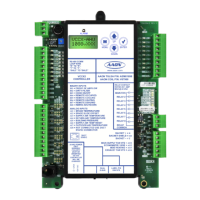32VCCX2 Controller Technical Guide
SEQUENCE OF OPERATIONS
Modes of Operation
There are eight possible HVAC Modes of Operation. They are as
follows:
• Cooling Mode
• Heating Mode
• Vent Mode
• Dehumidication Mode
• Purge Mode
• Defrost Mode (Heat Pump)
• Warm-Up Mode/Cool-Down Mode
• O Mode
Cooling Mode
Occupied Cooling is enabled when the temperature at the Mode
Enable Sensor rises one deadband above the Cooling Setpoint.
Cooling is disabled when the mode enable temperature falls one
deadband below the Cooling Setpoint. The setpoint and deadband
are user adjustable.
Unoccupied Cooling operation is enabled when the space
temperature rises above the Cooling Mode Enable Setpoint plus
the unoccupied cooling oset.
Mechanical cooling is disabled if the outdoor air temperature falls
1°F below the Cooling Lockout Setpoint and will remain disabled
until the outdoor air temperature rises 1°F above the Cooling
Lockout Setpoint. If the outdoor air temperature disables mechanical
cooling while it is currently operating, mechanical cooling will
stage o as minimum run times and stage down delays are satised.
If the economizer is enabled, it will function as the rst stage of
Cooling.
Cooling with the Refrigerant System Modules
On units with digital or VFD compressors, the VCCX2 Controller
will utilize one or more RSMs. Units with only fixed staged
compressors that are doing dehumidication or that require head
pressure control would also utilize an RSM. Each RSM will control
the compressors, condensers, and electronic expansion valves (on
VFD compressor units) for one or two refrigeration circuits. Up to
four RSMs may be used in controlling up to eight circuits.
The RSMD, RSMD2R, and RSMD-A are used for digital
compressor units. The RSMV is used for VFD compressor units
(non-heat pumps). The RSMV-HP is used for VFD compressor units
that are heat pumps. The RSMVQ, RSMVQ2R, and RSMVHPQ
are used on units with VFD controlled compressors. These modules
also communicate with independent electronic expansion valve
controllers.
In Cooling Mode, as the supply air temperature rises above the
active Cooling Supply Air Temperature Setpoint, the compressors
will stage on and modulate to maintain the active Supply Air Cooling
Setpoint. Each RSM will independently control its compressors to
achieve the most ecient cooling control. Each stage must meet
its minimum o time (adjustable) before it is allowed to energize.
Successive stages are subject to a cooling stage-up delay (adjustable).
Cooling stages will continue to run until the supply air temperature
falls below the active Supply Air Temperature Setpoint minus the
cooling stage control window and the Cooling will begin to stage
o. Each stage must meet its minimum run time (adjustable) before
it is allowed to stage o. Successive stages are subject to a cooling
stage down delay (adjustable). See the appropriate RSM Technical
Guide for a more detailed sequence of operation.
Staged Cooling without Refrigerant System Modules
An RSM will not be used on units with xed stage compressors that
are not doing dehumidication and that do not require head pressure
control, or on units with on/o chilled water.
In Cooling Mode, as the supply air temperature rises above the
active Supply Air Cooling Setpoint, cooling will begin to stage on.
Each stage must meet its minimum o time (adjustable) before it is
allowed to energize, and successive stages are subject to a cooling
stage-up delay (adjustable).
Cooling stages will continue to run until the SAT falls below the
active Supply Air Temperature Setpoint minus the cooling stage
control window at which point the Cooling will begin to stage o.
Each stage must meet its minimum run time (adjustable) before it
is allowed to stage o and successive stages are subject to a cooling
stage down delay (adjustable).
Modulating Chilled Water Cooling Control
In the Cooling Mode, as the supply air temperature rises above
the active Supply Air Cooling Setpoint. The modulating cooling
proportional window is used to determine the signal to the chilled
water valve and is user adjustable. The modulating cooling signal
is calculated based on the dierential between the supply air
temperature and the active Supply Air Temperature Setpoint based
on the modulating cooling proportional window.
The maximum signal adjustment per time period is 10% and is not
user adjustable. The minimum signal adjustment per time period is
based on the modulating cooling proportional window. The larger
the modulating cooling proportional window, the smaller the signal
adjustment will be per time period. The time period is the delay
between another increase or decrease in the chilled water cooling
signal and is user-adjustable. For example, if the modulating cooling
proportional window is 5°F, the signal would adjust 2% per 1°F
each time period above or below the active Supply Air Temperature
Setpoint. When the supply air temperature is above or below the
active Supply Air Temperature Setpoint by 5°F or more, the signal
would adjust 10% each time period.

